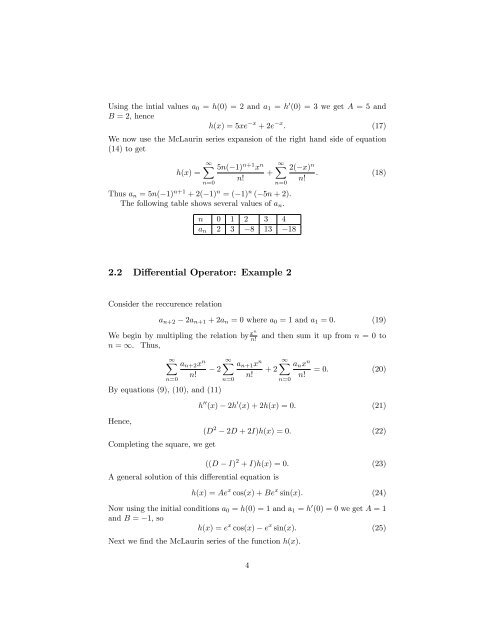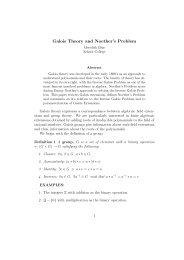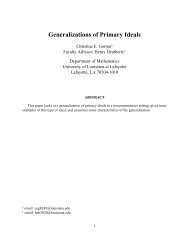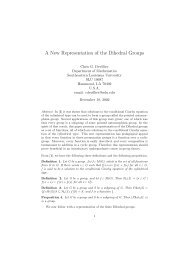Solving Recurrence Relations Using Differential Operators - Sections
Solving Recurrence Relations Using Differential Operators - Sections
Solving Recurrence Relations Using Differential Operators - Sections
Create successful ePaper yourself
Turn your PDF publications into a flip-book with our unique Google optimized e-Paper software.
<strong>Using</strong> the intial values a0 = h(0) = 2 and a1 = h 0 (0) = 3 we get A = 5 and<br />
B = 2; hence<br />
h(x) = 5xe x + 2e x : (17)<br />
We now use the McLaurin series expansion of the right hand side of equation<br />
(14) to get<br />
1X 5n( 1)<br />
h(x) =<br />
n+1xn 1X 2( x)<br />
+<br />
n!<br />
n<br />
: (18)<br />
n!<br />
n=0<br />
n=0<br />
Thus an = 5n( 1) n+1 + 2( 1) n = ( 1) n ( 5n + 2).<br />
The following table shows several values of an.<br />
n 0 1 2 3 4<br />
an 2 3 8 13 18<br />
2.2 Di¤erential Operator: Example 2<br />
Consider the reccurence relation<br />
an+2 2an+1 + 2an = 0 where a0 = 1 and a1 = 0: (19)<br />
We begin by multipling the relation by xn<br />
n! and then sum it up from n = 0 to<br />
n = 1. Thus,<br />
1X<br />
n=0<br />
an+2x n<br />
n!<br />
By equations (9), (10), and (11)<br />
Hence,<br />
2<br />
1X<br />
n=0<br />
an+1x n<br />
n!<br />
+ 2<br />
1X anxn = 0: (20)<br />
n!<br />
n=0<br />
h 00 (x) 2h 0 (x) + 2h(x) = 0: (21)<br />
(D 2<br />
Completing the square, we get<br />
A general solution of this di¤erential equation is<br />
2D + 2I)h(x) = 0: (22)<br />
((D I) 2 + I)h(x) = 0: (23)<br />
h(x) = Ae x cos(x) + Be x sin(x): (24)<br />
Now using the initial conditions a0 = h(0) = 1 and a1 = h 0 (0) = 0 we get A = 1<br />
and B = 1, so<br />
h(x) = e x cos(x) e x sin(x): (25)<br />
Next we …nd the McLaurin series of the function h(x).<br />
4

















